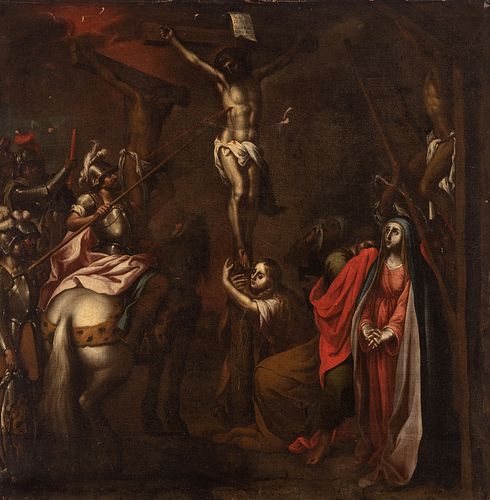Andalusian School; second half of the seventeenth century. "Calvary". Oil on canvas. Relined.
Lot 56
About Seller
Setdart Auction House
Carrer Aragó 346
Barcelona
Spain
Setdart Subastas was born in 2004 and is currently the first online art auction in Spain with solidity, prestige and reliability guaranteed by our more than 60,000 users. Setdart has a young, dynamic and enterprising team ready to successfully manage the purchase and sale of art works through custom...Read more
Estimate:
EUR€3,000 - EUR€4,000
$3,157.89 - $4,210.53
Absentee vs Live bid
Two ways to bid:
- Leave a max absentee bid and the platform will bid on your behalf up to your maximum bid during the live auction.
- Bid live during the auction and your bids will be submitted real-time to the auctioneer.
Bid Increments
| Price | Bid Increment |
|---|---|
| EUR€0 | EUR€10 |
| EUR€200 | EUR€25 |
| EUR€500 | EUR€50 |
| EUR€1,000 | EUR€100 |
| EUR€3,000 | EUR€200 |
| EUR€5,000 | EUR€500 |
| EUR€10,000 | EUR€1,000 |
| EUR€20,000 | EUR€2,000 |
| EUR€50,000 | EUR€5,000 |
About Auction
By Setdart Auction House
Oct 20, 2021
Set Reminder
2021-10-20 07:30:00
2021-10-20 07:30:00
America/New_York
Bidsquare
Bidsquare : OLD MASTERS
https://www.bidsquare.com/auctions/setdart-auction-house/old-masters-7700
Setdart Auction House sofia@setdart.com
Setdart Auction House sofia@setdart.com
- Lot Description
Andalusian School; second half of the seventeenth century. "Calvary". Oil on canvas. Relined. Presents jumps and repainting. Size: 125 x 123,5 cm. The scene that stands out for its expressiveness differs somewhat from the traditional form of representation of Calvary based on Byzantine Deesis, which represented Christ in Majesty accompanied by Mary and St. John the Baptist. In Western art, the representation of Christ on the cross was preferred, as a narrative scene, and the figure of St. John the Baptist was replaced by that of John the Evangelist. An image that in its conception and form is the result of the expression of the people and the deepest feelings that nestled in it. With the economy of the State broken, the nobility in decline and the high clergy burdened with heavy taxes, it was the monasteries, the parishes and the confraternities of clerics and laymen who promoted its development, the works sometimes being financed by popular subscription. Painting was thus forced to capture the prevailing ideals in these environments, which were none other than religious ones, at a time when the counter-reformist doctrine demanded from art a realistic language so that the faithful would understand and identify with what was represented, and an expression endowed with an intense emotional content to increase the fervor and devotion of the people. The religious subject is, therefore, the preferred theme of the Spanish sculpture of this period, which starts in the first decades of the century with a priority interest in capturing the natural, to progressively intensify throughout the century the expression of expressive values, which is achieved through the movement and variety of gestures, the use of light resources and the representation of moods and feelings. The 17th century marked the arrival of the Baroque in the Andalusian school, with the triumph of naturalism over Mannerist idealism, loose workmanship and many other aesthetic liberties. At this time the school reached its greatest splendor, both for the quality of the works and for the primordial rank of Sevillian Baroque painting. Thus, during the transition to Baroque we find Juan del Castillo, Antonio Mohedano and Francisco Herrera el Viejo, in whose works the rapid brushstroke and the crude realism of the style is already manifested, and Juan de Roelas, introducer of Venetian colorism. In the middle of the century the period reached its peak, with figures such as Zurbarán, a young Alonso Cano and Velázquez. Finally, in the last third of the century we find Murillo and Valdés Leal, founders in 1660 of an Academy where many of the painters active during the first quarter of the 18th century were trained, such as Meneses Osorio, Sebastián Gómez, Lucas Valdés and others.
- Shipping Info
-
In-house shipping available. Please inquire at admin@setdart.com.
-
- Buyer's Premium



 EUR
EUR CAD
CAD AUD
AUD GBP
GBP MXN
MXN HKD
HKD CNY
CNY MYR
MYR SEK
SEK SGD
SGD CHF
CHF THB
THB





